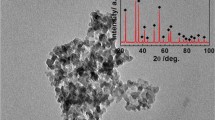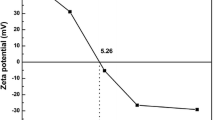Cr–C–Al2O3 deposits with different Al2O3 concentrations were successfully prepared on a Cu substrate from Cr3+-based electroplating baths. The microstructures of the Cr–C–Al2O3 deposits were examined using optical, scanning, and transmission electron microscopes. The hardness values, the corrosion and wear resistance of the Cr–C and Cr–C–Al2O3 deposited specimens were evaluated. Based on the experimental results, Al2O3 nanoparticles were uniformly distributed within the Cr–C deposits after electroplating in a Cr3+-based plating bath. The hardness values of the Cr–C–Al2O3 deposits increased with the Al2O3 concentration in the electroplating bath. The corrosion resistance of the Cr–C-deposited specimens could be noticeably improved by adding Al2O3 nanoparticles to the deposit. This is attributed to decrease in the number of cracks in the Cr–C specimens codeposited with Al2O3 nanoparticles. According to the transmission electron microscopy study, the crack-reduction mechanism in the Cr–C–Al2O3 deposits was proposed. The Cr–C–Al2O3 deposited specimen, which was prepared in an electroplating bath with an Al2O3 concentration of 50 g/L, had a relatively high corrosion resistance compared to the other specimens.





Similar content being viewed by others
References
M. Goldoni, A. Caglieri, D. Poli, et al., “Determination of hexavalent chromium in exhaled breath condensate and environmental air among chrome plating workers,” Anal. Chim. Acta, 562, 229–235 (2006).
S. Podgoric, B. J. Jones, R. Bulpett, et al., “Diamond-like carbon/epoxy low-friction coatings to replace electroplated chromium,” Wear, 267, 996–1001 (2009).
T. Sahraoui, N. Fenineche, G. Montavon, et al., “Alternative to chromium: characteristics and wear behavior of HVOF coatings for gas turbine shafts repair (heavy-duty),” J. Mater. Process. Technol., 152, 43–55 (2004).
Y. B. Song and D.-T. Chin, “Current efficiency and polarization behavior of trivalent chromium electrodeposition process,” Electrochim. Acta, 48, 349–356 (2002).
S. C. Kwon, M. Kim, S. U. Park, et al., “Characterization of intermediate Cr–C layer fabricated by electrodeposition in hexavalent and trivalent chromium baths,” Surf. Coat. Technol., 183, 151–156 (2004).
C. W. Chien, C. L. Liu, F. J. Chen, et al., “Microstructure and properties of carbon–sulfur-containing chromium deposits electroplated in trivalent chromium baths with thiosalicylic acid,” Electrochim. Acta, 72, 74–80 (2012).
C. A. Huang, Y. W. Liu, C. Yu, et al., “Role of carbon in the chromium deposit electroplated from a trivalent chromium-based bath,” Surf. Coat. Technol., 205, 3461–3466 (2011).
C. A. Huang, Y. W. Liu, and C. H. Chuang, “The hardening mechanism of a chromium–carbon deposit electroplated from a trivalent chromium-based bath,” Thin Solid Films, 517, 4902–4904 (2009).
W. X. Chen, J. P. Tu, H. Y. Gan, et al., “Electroless preparation and tribological properties of Ni–P–Carbon nanotube composite coatings under lubricated condition,” Surf. Coat. Technol., 160, 68–73 (2002).
I. Lyo, H. Ahn, and D. Lim, “Microstructure and tribological properties of plasma-sprayed chromium oxide–molybdenum oxide composite coatings,” Surf. Coat. Technol., 163–164, 413–421 (2003).
T. Borkar and S. P. Harimkar, “Effect of electrodeposition conditions and reinforcement content on microstructure and tribological properties of nickel composite coatings,” Surf. Coat. Technol., 205, 4124–4134 (2011).
L. Du, B. Xu, S. Dong, et al., “Preparation, microstructure and tribological properties of nano-Al2O3/Ni brush plated composite coatings,” Surf. Coat. Technol., 192, 311–316 (2005).
C. A. Huang, U. W. Liu, and C. H. Chuang, “Role of nickel undercoat and reduction-flame heating on the mechanical properties of Cr–C deposit electroplated from a trivalent chromium based bath,” Surf. Coat. Technol., 203, 2921–2926 (2009).
Z. Zeng, L. Wang, A. Liang, et al., “Tribological and electrochemical behavior of thick Cr–C alloy coatings electrodeposited in trivalent chromium bath as an alternative to conventional Cr coatings,” Electrochim. Acta, 52, 1366–1373 (2006).
Acknowledgements
The authors would like to thank the National Science Council of the Republic of China (ROC) for their support of this work under Contract No.: 98-2221-E-182-016-MY2.
Author information
Authors and Affiliations
Corresponding author
Additional information
Published in Poroshkovaya Metallurgiya, Vol. 55, Nos. 9–10 (511), pp. 116–123, 2016.
Rights and permissions
About this article
Cite this article
Huang, C.A., Chen, J.Y., Chuang, C.H. et al. Properties of Cr–C–Al2O3 Deposits Prepared on a Cu Substrate Using Cr3+-Based Plating Baths. Powder Metall Met Ceram 55, 596–602 (2017). https://doi.org/10.1007/s11106-017-9844-1
Received:
Published:
Issue Date:
DOI: https://doi.org/10.1007/s11106-017-9844-1




